A Holiday Gift: ‘The Champagne Society’ Membership 6-Month ($299) or 12-Month ($589) Subscription + Recent Champagne Arrivals
Champagne Enters ‘New Era’
Dear Friends,
Our brick-and-mortar may be in Birmingham, but here at Elie Wine, our eyes are always cast toward our spiritual home in French and Spanish wine country. Keeping up with the zeitgeist of vinology is a fascinating, ever-changing endeavor, and nowhere is this more true in Champagne, which has undergone more philosophical changes in the past two decades than in the past two centuries. Not only has a steadily warming planet offered once-marginal terroirs a chance to shine, the focus needle is gradually shifting to an appreciation of Champagne as, first and foremost, a wine. In a culture shift sometimes called the ‘Burgundianization of Champagne’, less attention is being paid to big-name brands (who will always have their share of the market) and more to relative newcomers who are showcasing the terroir of individual vineyards, and even plots within that vineyard, rather than simply lauding a Premier Cru village. There is no question that the quality of Champagne overall is improving with single-site expressions and riper grapes that still retain Champagne’s characteristic acidity.
Elie
Join The Champagne Society: Bimonthly Club
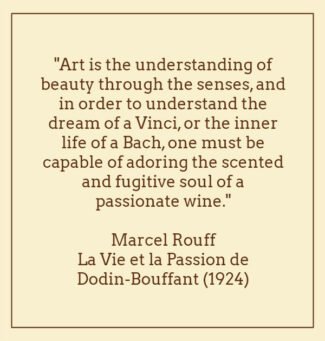 As a member of The Champagne Society, you’re in a select community of like-minded folks who appreciate the exceptional in life and recognize that sparkling wine is a superlative among man’s culinary creations. A bottle of Champagne is selected for you bimonthly. You will be drinking some of the best Champagne ever produced.
As a member of The Champagne Society, you’re in a select community of like-minded folks who appreciate the exceptional in life and recognize that sparkling wine is a superlative among man’s culinary creations. A bottle of Champagne is selected for you bimonthly. You will be drinking some of the best Champagne ever produced.
All selected wines are from passionate grower-producers or small houses deeply connected to the subtleties of each of their vine parcels and who believe that wine is made in the vineyard. Many of these wines are highly allocated, many bought directly, and we quite often only have access to a few cases of a particular cuvée. For more information visit The Champagne Society webpage.
A Gift That Keeps On Giving: Membership Subscription To ‘The Champagne Society’
Lily Bollinger once said, “I only drink champagne when I’m happy and when I’m sad. Sometimes I drink it when I’m alone. When I have company, I consider it obligatory; I trifle with it if I’m not in a hurry and drink it when I am, otherwise I never touch the stuff unless I am thirsty.”
Not only is Champagne the quintessential drink of celebration, it has traditionally been a gift given with ramped-up sentiments. This year we are offering a couple of variations on this theme, beginning with an opportunity to gift a special someone a six-month or twelve-month membership to The Champagne Society. Our pick for December will be packaged in a wrap-ready gift box along with a congratulatory certificate explaining what lies ahead in bi-monthly installments:
Six-Month Membership Gift ($299)
You will take home a pre-packaged, ready-for-gift-wrapping box containing The Champagne Society December Selection bottle, Champagne Marguet, with a certificate congratulating the recipient on their new membership to the Champagne Society, a select community of like-minded folks who appreciate the exceptional in life and recognize that wine is a superlative among man’s culinary creations. Then, in February and April, they are eligible to receive two more installments, one Champagne bottle each month (described in detail, in advance, by email), which they can stop by the store to pick up in person or have shipped directly to their home at no additional cost.
Twelve-Month Membership Gift ($589)
A full year’s membership in the Champagne Society includes a pre-packaged, ready-for-wrapping gift box containing The Champagne Society December Selection bottle, Champagne Marguet, along with a congratulatory certificate informing the recipient that they are now part of the Champagne Society, whose members are eligible for discounted prices on highly allocated Champagne, many bought directly, and many available only through Elie Wine Company. Then, in February and April, June, August and October, they are eligible to receive five more installments, one bottle of Champagne each month (described in detail, in advance, by email), which they can stop by the store to pick up in person or have shipped directly to their home at no additional cost.
RECENT ARRIVAL
Newly Added Champagne Producers
Over the past year, we have had the privilege of speaking to many Champagne producers located in what were once lesser known and (in terms of quality) marginally productive regions where warmer, dryer weather in the north of France has allowed a sort of renaissance. More and more growers, once under contract by international brands to produce a specific style of yield, are opting to exhibit instead their own unique microclimates and site-specific flavors. By shedding the yoke of corporate direction, they are able to choose their own pathways and bottle under their own labels. Interestingly, this includes more and more still wines as well as non-traditional blends, along with a growing emphasis on Meunier.
Many of the producers we now feature are the scions of old Champagne families who have taken a nonconformist and occasionally radical approach to an ancient craft. Most notably, biodynamics is increasingly mentioned in their techniques; in Vallée-de-la Marne, André Heucq and his daughter Fanny use the phases of the moon to bring cosmic significance to their vineyard. Grande-Vallée’s Laurent Bénard eschews the use of Sulfur and Olivier Langlais of La Petite Montagne-de-Reims’ Champagne Solemme does not blend wines from previous vintages—almost a rule in the region—releasing only wines from a single harvest.
These are wines we are grateful to add to our portfolio, not only because we admire the product, but because we are impressed with and gratified by the producers and their approach to a sustainable industry facing unprecedented climate challenges.
Champagne Pertois-Moriset (Côte-des-Blancs)
For some of us, a match made in Champagne is synonymous to one made in Heaven, and for Champagne Pertois-Moriset, it is family history. The house was born in 1951 with the nuptials of Yves Pertois from Cramant and Janine Moriset from Mesnil, both third-generation growers, who soon began bottling under their own label.
Today, the couple’s granddaughter Cécile and her husband Vincent Bauchet manage 50 acres divided between Chardonnay grown on Grand Cru sites in the Côtes de Blancs, plus a 60/40 split of Pinot Noir and Chardonnay in the Côte de Sézanne (including one parcel that borders Olivier Collin’s famed Les Maillons). Joined at the hip to organic and sustainable practices, Pertois-Moriset has become known for single-village expressions of renowned terroirs like Oger, Villeneuve, Cramant, and Chouilly, plus single-parcel bottlings from lieux-dits including Les Jeamprins, Les Jutées, and Les Hauts d’Aillerands. Members of Club Trésors de Champagne in Reims—a select group of 28 grower-producers, each authorized to produce a Special Club bottling that often involves blocking malolactic fermentation and extended bottle aging.
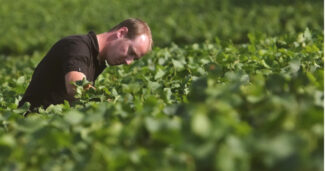
Vincent Bauchet, Champagne Pertois-Moriset
Vincent maintains that in every endeavor, the estate is attentive to the biodiversity that surrounds it: “If the years allow it,” he says,” no chemical inputs are applied on the vine. The vines are naturally grassed in winter, and in summer the soil is ploughed.”
Cécile adds: “We added a pressing center in 2009 equipped with two stainless-steel membrane presses, two thermo-regulated stainless-steel tanks, and a vat room for barrels and big oaks. The wine is bottled in June/July, in order to give the wine time to fully develop in tanks and barrels. The bottles then rest on the cellar, at least 20 months for the main vintages, and much longer for the vintages, thus guaranteeing wines with our signature aromas and flavors.”
Champagne Laurent Bénard (Grande-Vallée)
The tale of third-generation Champagne growers being wed and then bottling under their own name is echoed with the tale of Michelle and Laurent Bénard-Pitois. Located in Grande-Vallée, the estate has been organically certified since 2012 and, along with their son Charles, the couple produces about 10,000 bottles annually.
Laurent says, “When I took over the estate, I realized the imbalance in the vines translated to a lack of character and personality in the wines. The application of more thoughtful viticulture has allowed greater exchanges between the vines and their ecosystem, thus offering greater richness in our Champagne. We have worked sulfur-free since 2010 to ensure that the purity of the wine is not inhibited, while each pressing is vinified in the container which we believe allows it the most beautiful expression, whether it is wood, enameled steel or stainless steel.”
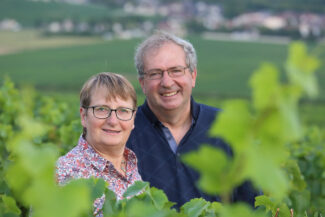
Michelle and Laurent Bénard, Champagne Laurent Bénard
His son Charles, with a double engineering degree in agronomy and oenology, joined in 2020. “Two choices were available,” he says. “Either I will look elsewhere and work for others, or come back as soon as possible in order to take full advantage of the experience of my parents and the domain team. I chose transmission; might as well have fun at home.”
Michelle adds, “The average age of our vines is now over 30 years; we gradually renew them with massal selection—cuttings are taken from several vines of the same variety that have collectively demonstrated desirable traits in order to preserve our genetic heritage and prepare for the future.”
Champagne André Heucq (Vallée-de-la Marne)
In the heart of the Marne valley is the tiny commune of Cuisles (population 150) which happens to be the epicenter for the green illite clay unique to Cuisles and two surrounding villages. It is arguably the terroir where Meunier feels most at home. According to André Heucq, who—along with his daughter Fanny— specializes in Pinot Meunier grown on fifteen acres of estate vineyards, “Green clay retains water better than chalky soils, this type of soil needs less water than classic clay-limestone soils. Generally speaking, the Marne Valley is prone to downpours of rain, and this is where Cuisles’ unique position in the hollow of the valley plays a fundamental role: Showers are much less frequent, so soil and climate are in perfect alchemy for optimum ripening of the Meunier.”
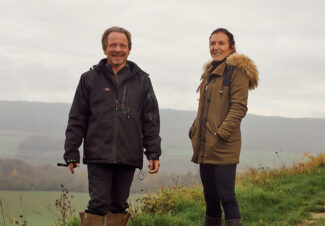
Alexandre & Fanny Heucq, Champagne André Heucq
Fanny says that the terroir, so vital to their wines’ purity and elegance, is enhanced by a commitment to biodynamics: “Production that respects the environment reactivates the vine’s natural self-defense mechanisms, allowing us do away with the use of chemicals and use very low doses of copper and sulfur.
Among the strictest (and most interesting) cosmos-oriented techniques the estate relies on is the ‘500’—a preparation is obtained by fermenting good quality cow manure in the soil over the winter, introduced via cow horns. Fanny explains, “This preparation is aimed at the soil and plant roots. Its name comes from the fact that it contains over 500 million bacteria per gram. The silica from the horn is equally important. it is complementary to and acts in polarity with the 500. It is not aimed at the soil, but at the aerial part of plants during their vegetative period. It can be said to be a kind of “light spray”, which can promote vegetative vigor or, on the contrary, attenuate excessive luxuriance. It brings a luminous (crystalline) quality to plants, and reduces their tendency to disease. Not only does it reinforce the effects of sunlight, it also enables a better relationship with the cosmic periphery, with the entire cosmos. This preparation is essential for the internal structuring and development of plants. It promotes vertical plant growth. It makes plants firmer and more supple. It increases the quality and resistance of leaf and fruit epidermis.”
Champagne Solemme (Montagne-de-Reims)
The name Solemme is a combination of ‘sol’ for the sun, with the addition of a feminine suffix. “My goal,” says cellar master Olivier Langlais, “is to make delicate Champagnes that are bright like the sun.”
La Petite Montagne-de-Reims, to the west of the road between Reims and Épernay, boasts steep slopes and chalky soils, making it the home of some of the best Premier Cru vineyards in Champagne—Savart, Brochet, Egly-Ouriet, etc. Also calling the region home is Olivier Langlais, who farms fifteen acres of organic vineyards in the terroir around Villers-Aux-Noeuds. A true exception in Champagne region, he makes wines using only the product of the harvest year.
His dedication to biodynamics and agriculture according to the cycles of the moon began with the Chardonnay plot in 2009 and finished the transition with his oldest vines of Pinot Noir in 2015. The vineyard is composed of 50% Meunier, 25% Chardonnay and 25% Pinot Noir divided between six villages—five of them Premier Cru. Most of the plots, as is the case of most Petit Montagne de Reims vines, are southeast/east oriented.
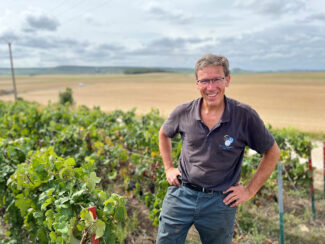
Olivier Langlais, Champagne Solemme
“Everything is happening in the exchange between the soil and the grape”, Olivier points out. “That’s why the difference of terroir between all parcels determines variety and process. Villers-aux-Noeuds has a classic chalky soil, bringing a lot of minerality to the Chardonnay and Meunier growing there. Clay-limestone dominates Chamery and Vrigny, with a bit more clay in Vrigny, where Meunier gets better results—clay gives more ‘gras’, or roundness to the grapes. Often not mentioned is the sandy soils of Villedomange and Eceuil, which gives Pinot Noir a concentrated and elegant form.”
Once in the cellar, Olivier is a champion of a hands-off approach. He never chaptalizes and uses only natural yeast from his vineyard. “In the chai, you won’t find any barrels,” he says. “We do not or filter, there is no addition of SO2 and all the cuvées spend between 36 to 48 months on the lees as a means of better expressing the terroir. 90% of the time, I don’t do any malolactic fermentation, because I prefer to let the natural minerality shine.”
Champagne Ullens (Montagne-de-Reims)
Whereas Champagne backstories may sometimes seem a bit cookie-cutter—long time grower families determined to start producing and labeling under their own name—but Champagne Ullens is a true iconoclast. Launched in 2012 by Belgian architect Maxime Ullens, he and his wife Anna purchased Domaine de Marzilly at the northern-most tip of the Montagne de Reims, intending only to renovate the abandoned farmhouse and barn. But tasting wine with the locals convinced them that they owned some fabulous terroir as well as old rootstocks that had been spared from phylloxera, and shortly, Maxime enrolled in the viticultural school in Avize.
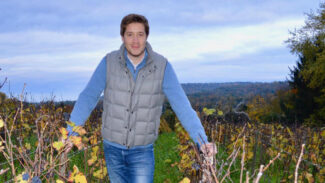
Maxime Ullens, Champagne Ullens
Also somewhat rare among Champagne producers, Maxime is somewhat obsessed with wood and ages his wine in 205 liter barrels, the original size in Champagne; the lumber for this is felled in the forests directly surrounding the vineyards and made into barrels by a local cooper.
Champagne Ullens uses exclusively organic methods in the care of their vineyards, and Maxime waits a minimum of twelve months in barrel and thirty-six months in bottle before disgorging his wines.
Champagne Jacquinet-Dumez (Montagne-de-Reims)
Champagne Jacquinet-Dumez first saw light in 1935 when Henri Dumez planted seven acres Pinot Noir in the Premier Cru village of Sacy. The family notes that he delivered his first cuvée to Paris personally, the bottles in the back of his van.
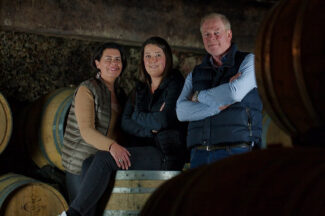
Aline, Diane and Olivier Jacquinet, Champagne Jacquinet-Dumez
Today, Aline and Olivier Jacquinet tend the property, having expanded the winery and invested in the success of multiple vintages. Their daughters Agathe and Diane work alongside them, bringing with them an interesting set of skills; Agathe has a Master degree in Marketing Perfumery and Cosmetics, having developed Ajnalogie, an innovative olfactory label. Diane has stuck closely with the vines, earning a National Diploma in oenology.
The philosophy of the House considers Champagne as an invitation to dialogue; they view their cuvées as the perfect trigger for sharing and exchange.
Champagne Vincent Couche (Côte-des-Bar)
Most Champagne folks spend a bit of time glorifying the past, but Vincent Couche is less about the roots and more about the fruits. With eyes facing steadily forward, he has taken his family’s 32 acres in the heart of the Côte-des-Bar and created his own dynamic, organic Shangri-La quite a distance from the mass-produced Champagnes of the region, embracing the natural wine movement and its obsession with healthy soils in the vineyard. He has practiced biodynamics since 1999 and maintains, “Picking is by taste and touch, with harvests often a week later than most of my neighbors. I refuse to chaptalize, so my grapes need higher sugar levels and higher levels of ripeness. Champagne is a cold place and our cellars are deep; natural fermentations take a long time, sometimes well into the spring after harvest. I ferment and age in oak without added yeast or nutrients—these wines don’t see any additions. All wines go through full malolactic fermentation and everything in the winery is done by gravity, without pumps and all the wines are unfiltered with dosage (final sugar addition) kept to a minimum, if any is added at all.
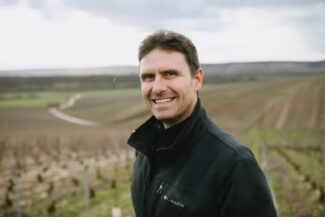
Vincent Couche, Champagne Vincent Couche
Couche’s vines are split into two distinct terroirs: He has roughly seven acres of Chardonnay in Montgueux planted on thin, chalky soils from the Cretaceous era and another 25 acres in Buxeuil planted primarily to Pinot Noir, where the soil consists of clay-limestone and clayey marls, depending on the parcel. The planting density is high and the vineyards are mainly south and west facing on steep hillsides with the Seine lying below. This area enjoys its own high temperatures microclimate and relatively good humidity thanks to the presence of the river near the vines.
Notebook ….
Drawing The Boundaries of The Champagne Region
Having been defined and delimited by laws passed in 1927, the geography of Champagne is easily explained in a paragraph, but it takes a lifetime to understand it.
Ninety-three miles east of Paris, Champagne’s production zone spreads across 319 villages and encompasses roughly 85,000 acres. 17 of those villages have a legal entitlement to Grand Cru ranking, while 42 may label their bottles ‘Premier Cru.’ Four main growing areas (Montagne de Reims, Vallée de la Marne, the Côte des Blancs and the Côte des Bar) encompass nearly 280,000 individual plots of vines, each measuring a little over one thousand square feet.
The lauded wine writer Peter Liem expands the number of sub-regions from four to seven, dividing the Vallée de la Marne into the Grand Vallée and the Vallée de la Marne; adding the Coteaux Sud d’Épernay and combining the disparate zones between the heart of Champagne and Côte de Bar into a single sub-zone.
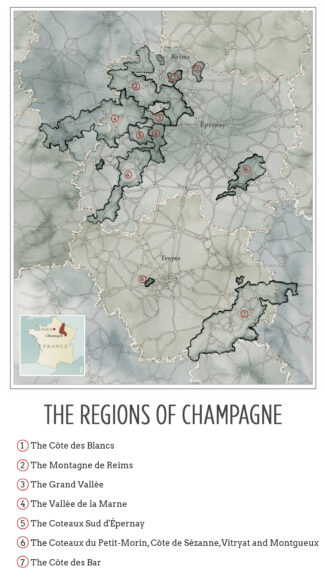
Lying beyond even Liem’s overview is a permutation of particulars; there are nearly as many micro-terroirs in Champagne as there are vineyard plots. Climate, subsoil and elevation are immutable; the talent, philosophies and techniques of the growers and producers are not. Ideally, every plot is worked according to its individual profile to establish a stamp of origin, creating unique wines that compliment or contrast when final cuvées are created.
Champagne is predominantly made up of relatively flat countryside where cereal grain is the agricultural mainstay. Gently undulating hills are higher and more pronounced in the north, near the Ardennes, and in the south, an area known as the Plateau de Langres, and the most renowned vineyards lie on the chalky hills to the southwest of Reims and around the town of Épernay. Moderately steep terrain creates ideal vineyard sites by combining the superb drainage characteristic of chalky soils with excellent sun exposure, especially on south and east facing slopes.
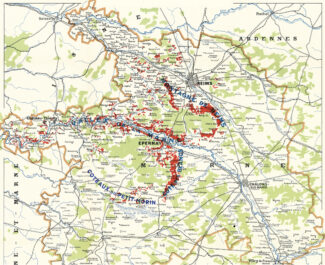
- - -
Posted on 2023.11.29 in France, Champagne
Featured Wines
- Notebook: A’Boudt Town
- Saturday Sips Wines
- Saturday Sips Review Club
- The Champagne Society
- Wine-Aid Packages
Wine Regions
Grape Varieties
Aglianico, Albarino, Albarín Blanco, Albarín Tinto, Albillo, Aleatico, Arbanne, Aubun, Barbarossa, barbera, Beaune, Biancu Gentile, bourboulenc, Cabernet Franc, Cabernet Sauvignon, Caino, Caladoc, Calvi, Carcajolu-Neru, Carignan, Chablis, Chardonnay, Chasselas, Clairette, Corvina, Cot, Counoise, Erbamat, Ferrol, Fiano, Frappato, Friulano, Fromenteau, Fumin, Garnacha, Gewurztraminer, Godello, Graciano, Grenache, Grolleau, Groppello, Juan Garcia, Lambrusco, Loureira, Macabeo, Macabou, Malvasia, Malvasia Nera, Marsanne, Marselan, Marzemino, Melon de Bourgogne, Merlot, Mondeuse, Montanaccia, Montepulciano, Morescola, Morescono, Moscatell, Muscadelle, Muscat, Natural, Nero d'Avola, Parellada, Patrimonio, Petit Meslier, Petit Verdot, Pineau d'Aunis, Pinot Auxerrois, Pinot Blanc, Pinot Gris, Pinot Meunier, Pinot Noir, Poulsard, Prieto Picudo, Rondinella, Rousanne, Roussanne, Sangiovese, Sauvignon Blanc, Savignin, Semillon, Souson, Sparkling, Sumoll, Sylvaner, Syrah, Tannat, Tempranillo, Trebbiano, Trebbiano Valtenesi, Treixadura, Trousseau, Ugni Blanc, vaccarèse, Verdicchio, Vermentino, Viognier, Viura, Xarel-loWines & Events by Date
- April 2024
- March 2024
- February 2024
- January 2024
- December 2023
- November 2023
- October 2023
- September 2023
- August 2023
- July 2023
- June 2023
- May 2023
- April 2023
- March 2023
- February 2023
- January 2023
- December 2022
- November 2022
- October 2022
- September 2022
- August 2022
- July 2022
- June 2022
- May 2022
- April 2022
- March 2022
- February 2022
- January 2022
- December 2021
- November 2021
- October 2021
- September 2021
- August 2021
- July 2021
- June 2021
- May 2021
- April 2021
- March 2021
- February 2021
- January 2021
- December 2020
- November 2020
- October 2020
- September 2020
- August 2020
- July 2020
- June 2020
- May 2020
- April 2020
- March 2020
- February 2020
- January 2020
- December 2019
- November 2019
- October 2019
- September 2019
- August 2019
- July 2019
- June 2019
- May 2019
- April 2019
- March 2019
- February 2019
- January 2019
- December 2018
- November 2018
- October 2018
- September 2018
- August 2018
- July 2018
- June 2018
- May 2018
- April 2018
- March 2018
- February 2018
- January 2018
- December 2017
- November 2017
- October 2017
- September 2017
- August 2017
- July 2017
- June 2017
- May 2017
- April 2017
- March 2017
- February 2017
- January 2017
- December 2016
- November 2016
- October 2016
- September 2016
- August 2016
- July 2016
- June 2016
- May 2016
- April 2016
- March 2016
- February 2016
- January 2016
- December 2015
- November 2015
- October 2015
- September 2015
- August 2015
- July 2015
- June 2015
- May 2015
- April 2015
- March 2015
- February 2015
- January 2015
- December 2014
- November 2014
- October 2014
- September 2014
- August 2014
- July 2014
- June 2014
- April 2014
- March 2014
- February 2014
- January 2014
- December 2013
- November 2013
- October 2013
- September 2013
- August 2013
- July 2013
- June 2013
- May 2013
- April 2013
- March 2013
- February 2013
- January 2013
- December 2012
- November 2012
- October 2012
- February 2004
Search



